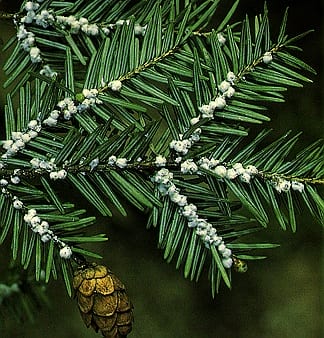Adelges abietis (eastern spruce gall adelgid), A. cooleyi (Cooley spruce gall adelgid) and A. tsugae (hemlock woolly adelgid)
Nymphs are soft-bodied and wingless. Mature nymphs, winged. Wingless are visible only with hand-lens. For example hemlock woolly adelgid is often buried within a cottony mass of wax.
Adelgids are found on Norway spruce; occasionally Colorado blue, red, and white spruce, several species of spruce & hemlock, Colorado blue, Engelmann, oriental, Sitka, white spruce,Douglas fir and are widely distributed in the United States.
Gall adelgids are characteristic cone-like galls. Stunting of twigs and death of new growth. Heavy infestations give tree a ragged appearance. Eastern spruce galls are near bases of twigs. Woolly adelgids; On hemlock, base of needles look like snow.
They have Complex life cycles often involve alternate host species.
Two typical cycles are;
- abietis: Overwinters as partially grown female (stem mother) which matures in early spring. Female lays eggs when new buds are ready to break. Eggs hatch within 10 days, and nymphs begin to feed on new needles, moving to bases of needles. As feeding continues, nymphs cause abnormal twig growth and gall development. Gall tissues grow around young insects, protecting them until galls crack open during mid-to-late summer. When galls open nearly mature nymphs crawl out onto a needle and transform to winged egg-layers. Eggs are deposited near tips of needles. Eggs hatch and partially grown nymphs attach themselves to a terminal twig, where they spend the winter.
- cooleyi: Overwinters as mature female on spruce. Female matures in spring to become a stem mother; lays eggs on tips of laterals. After eggs hatch nymphs migrate to new spring growth where they feed at the bases of needles. By mid-summer galls open and the insects move to needle tips and transform into winged females. These fly to another spruce or to the alternate host, Douglas fir, where eggs are laid on needles. A generation of woolly adelgidis produced.


